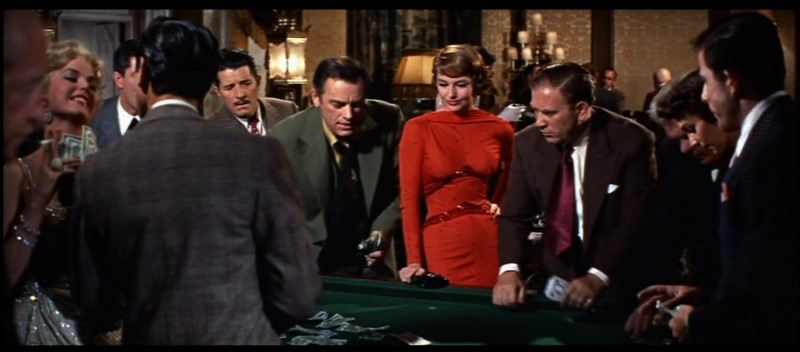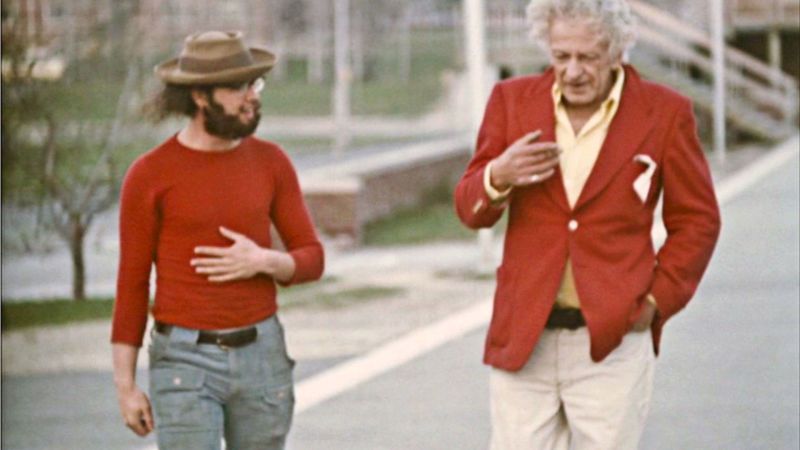We Can’t Go Home Again – Nicholas Ray, The Stranger | Kinostalgia
“Kinostalgia” is the title of a monthly column dedicated to repertory cinema, in which critic Victor Morozov picks well-known or undiscovered samples from the history of film and analyzes them from a fresh perspective. Today you can read about master Nicholas Ray’s last directorial effort.
At the beginning of the seventies, Nicholas Ray was coming back from far away – in every single sense of the word. First and foremost, from Europe, where Ray spent a decade jumping from country to country, without settling anywhere for too long, after buying the rights of literary works he wished to adapt or those of certain ideas he wanted to set on the big screen, from Spain all the way to Poland, and from Yugoslavia to Israel. But Ray was especially returning from an ardent interior exile, one copiously seasoned with alcohol, drugs, and gambling, all of which would end up turning him into a persona non grata at Hollywood, and prevent him from completing even the most modest of projects. It’s not energy that he lacked, but rather, the trust of others. Ray’s case is a very complicated one: it could be argued that his steep decline into inferno began on the occasion of his first longer European sojourn, during the shoot for Bitter Victory, his 1957 masterpiece war film, where he drank and lost money like there was no tomorrow – or it could even be James Dean’s death, with whom he shared a beautiful friendship, which came into being on the set of Rebel Without a Cause, in 1955. However, it’s clear that Ray, who plunged into the film industry after the collective experiences of the theater scene in New York in the thirties, where, together with Elia Kazan, he had a key role to play, was never really “at home” in Hollywood – and it’s precisely this paradox that ensured him a long-lasting cult amongst his followers. When Wim Wender was shooting Lighting Over Water in 1979, featuring a Nick Ray on death bed, he had the conscience of a “cine-son” (as Serge Daney calls it) who pays the cheque of his entire generation.
Because it is an entire generation that followed Ray and resonated with his way of imposing a personal style even in the midst of the toughest production constraints. Critic Jonathan Rosenbaum wrote somewhere that Ray is one of the first Hollywood directors who left implied the fact that two characters can actually make love to each other – and the short, yet incandescent sequences of distilled romance between two people who are almost always doomed (see They Live by Night or Johnny Guitar) were more than enough to derail those films from their predictable paths onto a modern, uninhibited cinema, one that no longer shied away from spiritual ruptures. (Another incurable romantic, Jean-Luc Godard, would learn a few lessons from this.) So why did I say that Ray is a complicated case? Because, after all, the man was a product of classical studios, used to having a lot of money on hand and very clear-cut work responsibilities, in which no-one had the right to butt in. And even if Ray always manifested some signs of deviancy (be it sexual, through sequences and allusions towards an unnerving kind of homoeroticism, or political, through his one-time adhesion to the American Communist Party), thus foretelling the color of the years of protest that would soon follow, he, himself, was never able to work again the way he did in the good old years. Therein lies the tragedy of a man who could almost never do what he wanted to, and surprisingly enough, it’s precisely this which gave him his force.

The story of this man, which began with Bogart and Howard Hughes and ended with Jim Jarmusch and Jon Jost, is much too long to be told here. It was remarkably documented by cinema historian Bernard Eisenschitz, under the title Roman américain. Les vies de Nicholas Ray. I won’t go into too many details, but all that I am going to say is that, while reading this biography, one ends up asking themselves how come Ray didn’t find his end much earlier, or even worse, how come he never ended up losing his sanity due to all the pressure that was surrounding him. I’ll only add the fact that his life story shows us something new: a fascination for marginal people from within the interior of a system one would have suspected is finely-tuned, but which, perhaps on their account as well, will end up combusting out of nowhere. It’s enough to take a look at such strange films as Wind Across the Everglades (1958) and Party Girl (1958), his last at Hollywood, in order to caress their pitfalls, to perceive the ways in which they’re betraying their own instability at the same time as they are forcing themselves to keep a smooth appearance under the glaze of their flashy colors. Party Girl is an amazing gangster movie, which hides behind a stiff structure only to sabotage it from within. And Wind Across the Everglades has a story that has so many plot holes that it barely even stands on its two own legs – but its grace, which lies at the limit of abstraction and seems to burst from an obligatory concision, reveals a vulnerable film, which struggled to make it to the projectionists’ cabin.
When Ray accepted a teaching post at a university close to New York, his few box office hits were already a memory. In a beautiful scene in the film that he is preparing at the time, a few students ask him somewhat defensively: “What are you doing here?”, “Are you the guy that made Rebel Without a Cause?”, and especially, “Aren’t you a bit too old to be our new teacher?” Too little inclined towards being a teacher – as the majority of his Hollywood collaborators claimed that they struggled to understand what he wanted to say – Ray sets about the challenge of making a new film together with his students. He will hold on to this fantastic initiative for many years, alienating those around him save for a few close collaborators, and determining the rest to describe the project as “slavery”. For some 20 to 22-year-olds, this will prove to be the most intense period of their lives. Ray collates everything that he has at his disposal – from the personal stories of his students to the events that surround him, shooting on Super-8, 16mm, and 35mm. During Ray’s leave from the United States, history starts to accelerate again: while in Europe, the director misses the assassination of Martin Luther King Jr. and the anti-Vietnam protests, but arrives just in time to catch the Trial of the Chicago Seven, which becomes the starting point of the film. We Can’t Go Home Again can hardly be classified as anything but a film of its times. In its formal madness – several screens are turning on at the same time and messily speaking over each-other, generating multiple layers of images and setting Ray somewhere between Abel Gance (Napoléon) and Godard (Numéro Deux) –, in its thematic generosity – from the teacher-student relation to politics –, in the moment’s most common tropes – sexuality and debauchery, psychedelic trips, handfuls of new ageism -, the film is a highly relevant document of pre-Watergate America.

That being said, is this also a fertile experiment? Personally, I won’t make a secret out of my preference for the aforementioned Hollywood films made by Ray – to which I’ll also add the pathological In a Lonely Place (1950). But a precious lesson says that a master must be followed to the edges of the earth, even while running the risk of disappointment – because the master is oftentimes one step ahead of us, even if we might only realize this much later. Blending self-derision and histrionic attitudes – I always felt that the pained screams of the artist in Lightning Over Water are aimed, at least a little bit, towards the camera – Ray might still not fully agree with what I’ve said: it’s the conclusion of the parable which the athletic guru, glowing in a red suit, his grey hair wild and an unmissaable cigarette between his fingers, slowly tells to his apprentice, and which ends on the legendary phrase, “Don’t expect too much from a teacher”.
On the other hand, there is a chance that this cocktail, which Ray made sure to sprinkle with just about anything – including his character’s death, twice over -, to be a little bit hard to stomach. For the filmmaker, the film must have arrived as a welcome and long-expected occasion to return to work – even if fragmented, chaotic, and feverish. After a long time, he, at last, had the chance of trying all sorts of formal gimmicks, giving in to an earlier avant-gardist impulse, and especially to return to a work with actors based on Stanislavski and Vakhtangov. (Ray always bet less on technique and more on interpretation and improvisation – it was the central domain of his influence on set.) Presented in a special screening at the French Cinematheque in 1973, and then, shortly after, even at Cannes, the film was then edited and re-edited by Ray, who always found something more to adjust; in 1979, while shooting with Wenders, Ray is still screening the film’s work-in-progress edit. Even more paranoid than De Palma’s Snake Eyes, and more instinctual than Gance’s Napoléon, We Can’t Go Home Again might very well be harder to approach than either of them. With it, Ray seems to have truly made one from the heart – a special film for those who are willing to follow in its tracks to the very end. A stranger without a home – the documentary that was shot around the film is called I’m a Stranger Here Myself –, Nick Ray was never more understood and respected than in the presence of this gang of rebel kids who kept him company in his final years, and whom he foreshadowed in many ways when the world was looking the other way. Ray’s youth was always irrefutable.
We Can’t Go Home Again is available on MUBI.
Title
We Can't Go Home Again
Director/ Screenwriter
Nicholas Ray
Actors
Richard Bock, Tom Farrell, Danny Fisher
Country
SUA
Year
1973
Film critic and journalist; writes regularly for Dilema Veche and Scena9. Doing a MA film theory programme in Paris.


